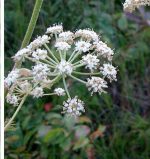 Hairy angelica is a herbaceous perennial and a member of the parsley family, Apiaceae, that also includes celery, Queen Anne’s lace, and poison hemlock. It is native to Eastern US from Massachusetts to Minnesota, south to Florida, Mississippi and Arkansas where it grows in open woods, clearings, meadows, glades, and roadsides. Plants grow 1-4′ tall from a deep, branched taproot and have stems covered with fine white hairs at their extremities. The dark green leaves are 2-3 times compound and have elliptical to lanceolate toothed leaflets up to 2″ long. In summer, terminal flat-topped compound umbels of small white flowers appear on long somewhat hairy stalks. Plants are attractive in wildflower gardens and the flowers are good in the vase. The genus name, Angelica, is the feminine form of the late Latin word angelicus and alludes to the supposed magical properties associated with the plant. The specific epithet, venenosa, comes from the Latin word venenum meaning poison, and refers to the toxic nature of the root.
Hairy angelica is a herbaceous perennial and a member of the parsley family, Apiaceae, that also includes celery, Queen Anne’s lace, and poison hemlock. It is native to Eastern US from Massachusetts to Minnesota, south to Florida, Mississippi and Arkansas where it grows in open woods, clearings, meadows, glades, and roadsides. Plants grow 1-4′ tall from a deep, branched taproot and have stems covered with fine white hairs at their extremities. The dark green leaves are 2-3 times compound and have elliptical to lanceolate toothed leaflets up to 2″ long. In summer, terminal flat-topped compound umbels of small white flowers appear on long somewhat hairy stalks. Plants are attractive in wildflower gardens and the flowers are good in the vase. The genus name, Angelica, is the feminine form of the late Latin word angelicus and alludes to the supposed magical properties associated with the plant. The specific epithet, venenosa, comes from the Latin word venenum meaning poison, and refers to the toxic nature of the root.
Type: Herbaceous perennial
Bloom: Terminal flat-topped compound umbels of small white flowers in summer
Size: 1-4′ H x 1-4′ W
Light: Full sun to part shade
Soil: Average, moist, well-drained; drought resistant and tolerant of lean soil.
Hardiness: Zones 4-8
Care: Low maintenance
Pests and Diseases: None of significance
Propagation: Seed
Companion Plants: Lupine, blazing star, rudbeckia, butterfly weed. tall coreopsis
Photo Credit: Mason Brock